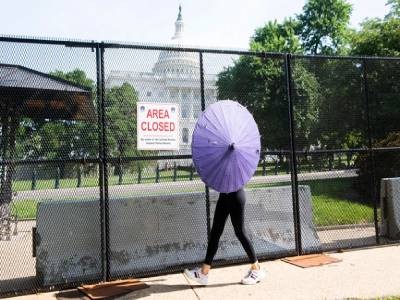“Unprecedented”: That’s how a new assessment released by the administration of President Joe Biden describes the toll that climate change is taking on the United States.
Global warming causes US$150 billion in direct damages across the country each year, whether owing to rising seas, heat waves, droughts or floods, and the costs are rising, says the climate report, released on 14 November. From 2018–2022, the United States experienced 89 climate disasters that cost at least $1 billion in damages. That equates to one every three weeks, as compared with one every four months in the 1980s.

Influential US climate report moves ahead — under new leadership
This year, a wildfire in Maui killed at least 97 people — the deadliest US wildfire in more than a century — and the first-ever tropical storm watch was issued for southern California in the wake of Hurricane Hillary.
“Climate change is here,” says Arati Prabhakar, Biden’s chief science adviser and director of the White House Office of Science and Technology Policy. But Prabhakar says that the United States is stepping up to the challenge with significant new climate investments, “and this gives us hope that we can move at a scale that the climate notices”.
The fifth National Climate Assessment is technically a year overdue. By law, the US government must complete the report every four years, reviewing the latest climate science and offering guidance to state and local officials grappling with decisions about how to adapt to global warming. The last one was issued in 2018, after which the administration of former president Donald Trump appointed a climate sceptic to head the process of drafting the next report. The Biden administration assembled a new team after taking charge in 2021, and more than 500 authors worked on the final version.
A drought that began in 2000 (left) has caused the Colorado River’s levels to drop steadily. Lake Mead, a reservoir along the river in Nevada and Arizona, was filled to just 27% capacity in 2022 (right). The reservoir supplies water to millions.Credit: NASA via Shutterstock
In parallel with the report’s release, the White House announced more than $6 billion in new investments, funded through a pair of landmark laws that provide historic boosts in funding for infrastructure, clean energy and climate resilience. That includes $3.9 billion to modernize the US electric grid, $2 billion for community grants focused on environmental justice and several hundred million targeted at helping communities to secure reliable water supplies and to become more resilient to flooding.
“This is not about curling up in a corner in despair,” says Rachel Cleetus, policy director and lead economist for the Climate and Energy Program at the Union of Concerned Scientists, an advocacy group based in Cambridge, Massachusetts. “There are very concrete steps we can take to cut our emissions and to promote climate resilience.”
Actions matter
After taking office, Biden had the United States rejoin the United Nations’ Paris climate agreement, which Trump had exited. Biden also committed the country to halving its greenhouse-gas emissions by 2030, compared with 2005 levels, and to achieving net-zero emissions by mid-century. The new climate assessment makes it clear that the United States is so far falling short on those goals.

Climate change is hitting the planet faster than scientists originally thought
The nation’s total greenhouse-gas emissions fell by around 17% between 2005 and 2021, according to the latest US emissions report to the United Nations climate convention. The pace of emissions reductions needs to increase from around 1% per year to roughly 6% per year to meet the country’s mid-century targets.
Released just weeks before the next big United Nations climate summit, where countries will come together to address the global-warming crisis, the report underscores the collective nature of the problem. Until the world stops pumping greenhouse gases into the atmosphere, the effects of climate change will continue to increase. At the same time, the report also underscores the idea that every fraction of a degree of warming matters, which also means that every action taken to reduce emissions will lower the risks and impacts of climate change going forward.
That’s a message that should ring loudly to the public and to policymakers, says Katherine Hayhoe, chief scientist with The Nature Conservancy, a conservation group based in Arlington, Virginia, and an author on the report. “Our actions matter,” Hayhoe says, “and that’s the science”.
‘A breath of fresh air’
The report also focuses on environmental and social justice, the quest to address pollution and climate impacts that disproportionately affect marginalized — and often minority — communities. In fact, for the first time, it includes a specific chapter on the topic, as well as a chapter on Indigenous peoples that was led by mostly native scholars.

US pledges to dramatically slash greenhouse emissions over next decade
“It’s a breath of fresh air,” says Kyle Whyte, a member of the Citizen Potawatomi Nation who studies environmental justice at the University of Michigan in Ann Arbor. A lead author on the chapter on Indigenous peoples, Whyte says the report highlights Indigenous rights alongside climate solutions. “In many native communities, our infrastructure is not up to the task of protecting our populations from the massive climate impacts that threaten us.”
For Cleetus, the report weaves a compelling picture about the need for fairness and equity as the country moves to build a clean-energy economy. Policymakers need to make sure that marginalized communities — many of which depend on the fossil-fuel industry for jobs — see the full benefits as well, she says.
“Let’s not replicate old injustices as we build a clean-energy economy,” she says.
